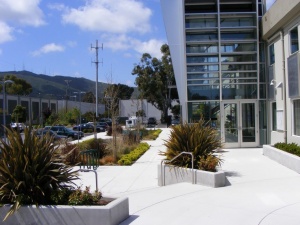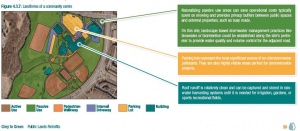Difference between revisions of "LID opportunities at municipal facilities"
Kyle menken (talk | contribs) |
|||
| (19 intermediate revisions by 3 users not shown) | |||
| Line 1: | Line 1: | ||
| − | + | Each distinct area of your site can be a source for runoff (referred to as a ‘source area’). Target these areas when introducing LID in your municipal facility. | |
| − | Each distinct area of your site can be a source for runoff (referred to as a ‘source area’). | ||
=== Targeting hard surfaces === | === Targeting hard surfaces === | ||
| Line 12: | Line 11: | ||
[[File:Bioretention_Planters_1.jpeg|thumb|[[Stormwater planters]] beautify this building entrance. The entrance receives a lot of traffic during business hours, making it an ideal location for a high visibility LID practice. (Source: Aquafor Beech)]] | [[File:Bioretention_Planters_1.jpeg|thumb|[[Stormwater planters]] beautify this building entrance. The entrance receives a lot of traffic during business hours, making it an ideal location for a high visibility LID practice. (Source: Aquafor Beech)]] | ||
| − | [[Permeable | + | [[Permeable pavements]] are also an option in large municipal parking lots. Pervious concrete, permeable interlocking concrete pavers, and porous asphalt can detain stormwater and increase infiltration. |
Municipal facilities provide excellent opportunities for integrating [[rainwater harvesting]] systems. Rainwater harvesting systems have two requirements: an area for catchment of relatively clean runoff and a nearby demand for water usage. Municipal facilities often have large rooftop areas producing relatively clean runoff. Installing a cistern internal to the building or buried adjacent to the building can provide a sustainable source of water for site irrigation needs for landscaped areas, recreational fields and indoor use (e.g. flushing toilets and urinals). | Municipal facilities provide excellent opportunities for integrating [[rainwater harvesting]] systems. Rainwater harvesting systems have two requirements: an area for catchment of relatively clean runoff and a nearby demand for water usage. Municipal facilities often have large rooftop areas producing relatively clean runoff. Installing a cistern internal to the building or buried adjacent to the building can provide a sustainable source of water for site irrigation needs for landscaped areas, recreational fields and indoor use (e.g. flushing toilets and urinals). | ||
=== Targeting highly visible areas === | === Targeting highly visible areas === | ||
| − | If your LID integration strategy involves highly visible LID practices, consider targeting areas with high-volume pedestrian traffic. This can help promote LID's visibility among the public and increase support for future LID projects. | + | If your LID integration strategy involves highly visible LID practices, consider targeting areas with high-volume pedestrian traffic. This can help promote LID's visibility among the public and increase support for future LID projects. |
=== Targeting pollution prevention opportunities === | === Targeting pollution prevention opportunities === | ||
| − | On some municipal sites, pollution prevention techniques and strategies | + | On some municipal sites, [[Pollution prevention|pollution prevention]] techniques and strategies are the best approaches to mitigating the environmental impact of your site. Retrofits of municipal works yards require a different approach than other land uses discussed in this guide. Works yards do not offer substantial opportunities for public interaction. LID retrofits should focus primarily on reducing pollution generated on-site. Fueling stations, waste storage areas, truck washing stations, sand and salt storage, staging areas and water conveyance features are ideal for pollution prevention. |
| − | pollution prevention. | ||
=== Source areas === | === Source areas === | ||
The best LID option for your site will depend what source areas are present. Types of source areas include: | The best LID option for your site will depend what source areas are present. Types of source areas include: | ||
| + | [[File:Figure 4.3.7 (G-to-G Public Lands).JPG|thumb|Source areas within a typical community centre.]] | ||
*Active use areas | *Active use areas | ||
*Passive use areas | *Passive use areas | ||
| Line 33: | Line 32: | ||
On municipal sites, pollution prevention is often associated with changes to operations and maintenance practices and has not been included in the table below. | On municipal sites, pollution prevention is often associated with changes to operations and maintenance practices and has not been included in the table below. | ||
| − | {| class="wikitable sortable" | + | {| class="wikitable sortable" style="text-align: center;" |
| − | |+LID opportunities in | + | |+ LID opportunities in municipal buildings <br> |
(** = Common, * = Possible, o = Unusual) | (** = Common, * = Possible, o = Unusual) | ||
| + | ! Source area | ||
| + | ! [[Permeable pavements]] | ||
| + | ! [[Bioretention]] | ||
| + | ! [[Enhanced grass swales]] / [[Bioswales|bioswales]] | ||
| + | ! [[Green roofs]] | ||
| + | ! Soakaways and [[Infiltration chambers|infiltration chambers]] | ||
| + | ! [[Exfiltration trenches|Perforated pipe systems]] | ||
| + | ! [[Rainwater harvesting]] | ||
| + | ! [[Landscape alternatives]] | ||
| + | ! Prefabricated modules | ||
| + | ! [[Pollution prevention]] | ||
|- | |- | ||
| − | + | |style="text-align: left;" |Active use area || ** || ** || ** || o || ** || * || o || * || o || ** | |
| − | |||
| − | |||
| − | |||
| − | |||
| − | |||
| − | |||
| − | |||
| − | |||
|- | |- | ||
| − | + | |style="text-align: left;" |Passive use area || o || ** || * || o || ** || ** || o || ** || ** || ** | |
|- | |- | ||
| − | + | |style="text-align: left;" |Pedestrian walkway || ** || ** || ** || o || ** || * || o || * || * || ** | |
|- | |- | ||
| − | + | |style="text-align: left;" |Internal driveway || ** || ** || ** || o || ** || ** || o || o || ** || ** | |
|- | |- | ||
| − | + | |style="text-align: left;" |Parking lot || ** || ** || ** || o || ** || ** || o || o || ** || ** | |
|- | |- | ||
| − | + | |style="text-align: left;" |Building || * || * || * || ** || ** || * || ** || o || o || ** | |
|} | |} | ||
| − | |||
| − | |||
[[Category:Planning]] | [[Category:Planning]] | ||
Latest revision as of 18:35, 6 August 2020
Each distinct area of your site can be a source for runoff (referred to as a ‘source area’). Target these areas when introducing LID in your municipal facility.
Targeting hard surfaces[edit]
Municipal facilities have large parking lots to accommodate public demand. Parking areas represent the most significant source of pollutant loading from these sites and contribute significantly to increased runoff rates in comparison to natural conditions. Parking lots include areas for parking, areas for driving, and islands or landscape planters used for calming traffic, directing vehicles and improving pedestrian safety.
LID practices can be incorporated into all areas of a parking lot. You can use bioretention in parking lot islands and along the lot perimeter. Standard curbs with small cut-outs (called ‘curb cuts’) can allow water to easily enter biorentention practices while also preventing damage from cars.
Bioswales are excellent options in parking lot islands or along lot perimeters. Parking lots with existing perimeter ditching are ideal for bioswale integration due to their extended continuous flow path.
Prefabricated modular infiltration chambers are gaining acceptance for their easy integration with parking lot functions. These subsurface systems are typically installed over a coarse granular reservoir to provide storage and allow infiltration into native soils. Infiltration chambers under conventional asphalt system work well on sites where parking demand and other site uses do not allow space for a stormwater feature.

Permeable pavements are also an option in large municipal parking lots. Pervious concrete, permeable interlocking concrete pavers, and porous asphalt can detain stormwater and increase infiltration.
Municipal facilities provide excellent opportunities for integrating rainwater harvesting systems. Rainwater harvesting systems have two requirements: an area for catchment of relatively clean runoff and a nearby demand for water usage. Municipal facilities often have large rooftop areas producing relatively clean runoff. Installing a cistern internal to the building or buried adjacent to the building can provide a sustainable source of water for site irrigation needs for landscaped areas, recreational fields and indoor use (e.g. flushing toilets and urinals).
Targeting highly visible areas[edit]
If your LID integration strategy involves highly visible LID practices, consider targeting areas with high-volume pedestrian traffic. This can help promote LID's visibility among the public and increase support for future LID projects.
Targeting pollution prevention opportunities[edit]
On some municipal sites, pollution prevention techniques and strategies are the best approaches to mitigating the environmental impact of your site. Retrofits of municipal works yards require a different approach than other land uses discussed in this guide. Works yards do not offer substantial opportunities for public interaction. LID retrofits should focus primarily on reducing pollution generated on-site. Fueling stations, waste storage areas, truck washing stations, sand and salt storage, staging areas and water conveyance features are ideal for pollution prevention.
Source areas[edit]
The best LID option for your site will depend what source areas are present. Types of source areas include:
- Active use areas
- Passive use areas
- Pedestrian walkways
- Internal driveways
- Parking lots
On municipal sites, pollution prevention is often associated with changes to operations and maintenance practices and has not been included in the table below.
| Source area | Permeable pavements | Bioretention | Enhanced grass swales / bioswales | Green roofs | Soakaways and infiltration chambers | Perforated pipe systems | Rainwater harvesting | Landscape alternatives | Prefabricated modules | Pollution prevention |
|---|---|---|---|---|---|---|---|---|---|---|
| Active use area | ** | ** | ** | o | ** | * | o | * | o | ** |
| Passive use area | o | ** | * | o | ** | ** | o | ** | ** | ** |
| Pedestrian walkway | ** | ** | ** | o | ** | * | o | * | * | ** |
| Internal driveway | ** | ** | ** | o | ** | ** | o | o | ** | ** |
| Parking lot | ** | ** | ** | o | ** | ** | o | o | ** | ** |
| Building | * | * | * | ** | ** | * | ** | o | o | ** |
